Methyl 2-bromothiophene-3-carboxylate: Synthesis, Properties, and Applications in Organic Chemistry
Discover the versatility of this key heterocyclic intermediate in drug discovery, materials science, and beyond.
Get a Quote & SampleProduct Core Value

Methyl 2-bromothiophene-3-carboxylate
This compound is a critical intermediate in organic synthesis, valued for its unique thiophene structure and reactive bromine atom. It serves as a foundational element for creating complex molecules with diverse applications, from pharmaceuticals to advanced electronic materials.
- A vital component for organic synthesis, enabling the development of complex thiophene derivatives. This makes it instrumental in advancing research in areas like medicinal chemistry and material science.
- Possesses significant potential in drug discovery, showing promising antimicrobial and anticancer activities. Researchers utilize its structure to develop new therapeutic agents, exploring its use in anticancer drug development intermediates.
- Key precursor for advanced materials, including conductive polymers and organic semiconductors, essential for next-generation electronic devices like OLEDs. This aligns with interests in thiophene chemistry in materials science.
- A versatile building block for agrochemical research, contributing to the design of more effective and potentially eco-friendly pesticides, supporting the field of sustainable chemistry and pesticide design.
Advantages Offered
Enhanced Reactivity
The presence of the bromine atom on the thiophene ring significantly boosts its reactivity, facilitating a wide range of chemical transformations for creating novel compounds.
Broad Application Spectrum
Its utility spans multiple industries, acting as a crucial intermediate in the synthesis of pharmaceuticals, agrochemicals, and high-performance materials, demonstrating its role in chemical intermediate synthesis optimization.
Structural Versatility
The thiophene core, coupled with the ester and bromine substituents, offers extensive possibilities for functionalization, making it a favored choice for researchers seeking diverse molecular structures.
Key Applications
Medicinal Chemistry
Serves as a scaffold for developing new drugs, particularly those with antimicrobial and anticancer properties, vital for heterocyclic compounds in drug discovery.
Material Science
Essential for creating conductive polymers and organic semiconductors used in advanced electronic devices, particularly relevant for thiophene derivatives for OLEDs.
Agrochemicals
A key intermediate in the development of pesticides, contributing to more sustainable agricultural practices through its role in eco-friendly pesticide intermediates.
Organic Synthesis
A fundamental building block that enables chemists to construct complex molecular architectures efficiently, supporting advancements in organic synthesis.
